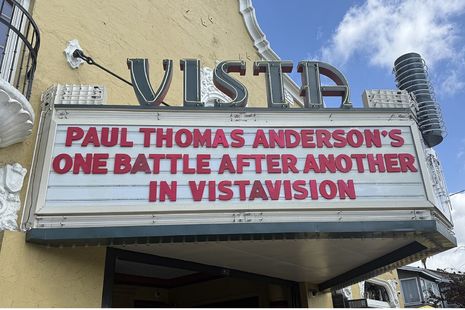Bringing film back to the silver screen
Jacob Smith explores the history of, and renewed interest in, analogue film

When George Lucas announced that Star Wars: Episode II – Attack Of The Clones would be shot entirely with digital cameras, it marked a new era for the silver screen. The first Hollywood movie to be fully digital, Attack Of The Clones was meant to convince the general audience, and executives, that digital cinema was capable of capturing the cinematic shots and angles previously brought to life by film.
Since the first film format was developed in 1888, 90mm, formats have developed rapidly. That all changed with Lucas’s prequel trilogy, pushing cinema into an era of accessibility, versatility, and CGI. Yet this past year has showcased a rebellion in cinema, a passionate cry for film to be reborn, to dominate once more. With the release of Paul Thomas Anderson’s One Battle After Another, shot entirely on Vistavision film, now is the perfect moment to explore the rise and fall of digital, and the resurgence of film on the silver screen.
“This past year has showcased a rebellion in cinema, a passionate cry for film to be reborn”
Lucas’s stride into a new generation of cinema was fueled by several advantages. Film, especially higher quality formats such as 65mm, IMAX, Vistavision and Super 35mm, comes with significant costs. Traditional 35mm film is run vertically, with perforations running along each frame dictating the size, and therefore quality, of the shots. Essentially, the more perforations, the taller, and more cinematic, the frame. Generally, ‘4 perf 35mm’ was the standard format before digital, synonymous with that classic cinematic style showcased by movies such as Jurassic Park. However, it was an expensive endeavor.
As technology progressed, the discovery of horizontal film formats birthed IMAX and Vistavision. Running the film horizontally through the camera rather than vertically allowed for each frame to have eight perforations, in the case of Vistavision, and 15 perforations in IMAX, rather than the traditional four. This significantly upscaled quality, and produced, to this day, unrivalled cinematography. However, there was no way of reducing the costs or labour of shooting horizontally. It took significantly longer spools of film, and much larger, and noisier camera equipment to compensate for it.
As the limitations of these formats were being noticed, American filmmakers were becoming interested in more portable, adaptable formats, seen in European arthouse cinema, where shooting on location rather than in a sterile studio was popular. This led to the adoption of digital film. It didn’t require hulking, noisy machinery, nor was it extortionately expensive to produce. It was adaptable, with variable frame ratios, immediate digital viewing and vastly superior editing capabilities. It was accessible, and with the exploration of digital visual effects such as CGI coinciding with it, even favourable.
“Digital lacks the imperfections embedded into film which reflect the dirtied, lived-in way we view the world around us”
However, digital is not without significant flaws. Its mass adoption led to a fast and now strongly felt oversaturation on the silver screen, its standardised image generally feeling flatter, almost too perfect, too spotless. It lacks the imperfections embedded into film which reflect the dirtied, lived-in way we view the world around us. It created an image that, to some, felt as if it was missing some intangible quality of life. The grain of the film, the subtle distortion due to light or dust, its varying and unique colour spectrums – these effects had to be digitally imposed onto digital footage, an artifice we seem to subconsciously detect. Film was used universally, and it’s important to note the nostalgia tethered to the format. Within the grain of film lies a family’s home videos, a Christmas day, or a wedding. It evokes memories that even my generation, who grew up primarily with digital film, can relate to.
In an age of digital fatigue and oversaturation, cinema needs a stylistic trademark to distinguish itself from streaming and to recapture film’s lived-in feel. This has led to the explosion of film once more on the Hollywood screen. In the past two years, Anora, The Brutalist, Oppenheimer, Sinners, One Battle After Another, and the upcoming Wuthering Heights and The Odyssey have been shot either partially or entirely with film.
These movies have been hailed for their visual flair and unique aesthetics, and it is nearly entirely due to their attempts to revive the otherwise abandoned formats of Vistavision and IMAX film. Before The Brutalist, Vistavision had last been used in its ‘golden era’ in One Eyed Jacks (1961). In an age of decline for cinema, as streaming provides a cosy alternative, now is the time to experiment with, rediscover, and revive film. We can only hope more and more native film projectors become available in the future, so we can watch these films the way they were intended to be seen.
 News / East West Rail proposes new Cambridge East station26 November 2025
News / East West Rail proposes new Cambridge East station26 November 2025 News / News in Brief: Cat-astrophic climbs, concealed collections, and Christmas festivities25 November 2025
News / News in Brief: Cat-astrophic climbs, concealed collections, and Christmas festivities25 November 2025 Comment / Don’t get lost in the Bermuda Triangle of job hunting 24 November 2025
Comment / Don’t get lost in the Bermuda Triangle of job hunting 24 November 2025 Features / Why are we so obsessed with getting more done?26 November 2025
Features / Why are we so obsessed with getting more done?26 November 2025 Comment / Cambridge can’t beat AI26 November 2025
Comment / Cambridge can’t beat AI26 November 2025










